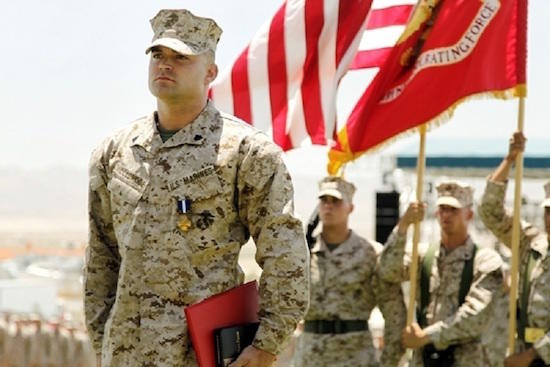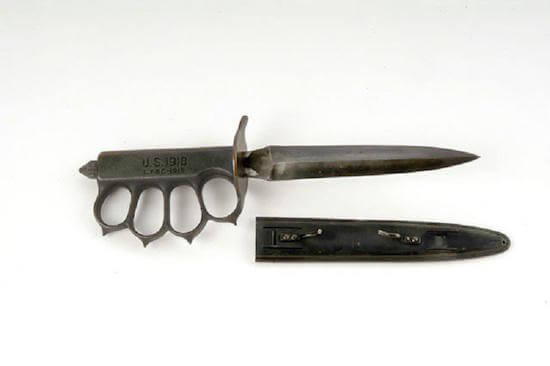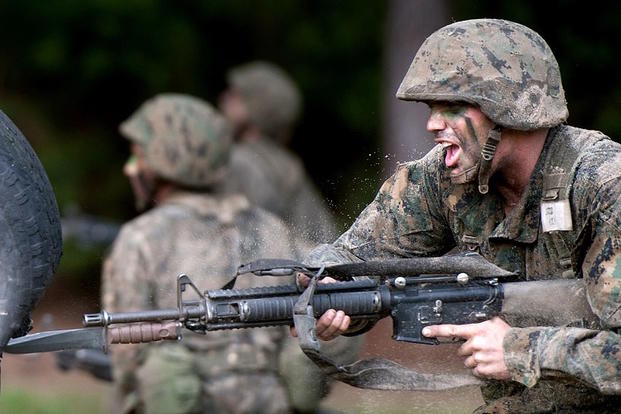This article by James Clark originally appeared on Task & Purpose, a digital news and culture publication dedicated to military and veterans issues.
Is there less courage on the battlefield today than during previous wars? If you only looked at the number of awards for valor presented to service members, you might get that impression. There’s been a noticeable decrease in valor citations issued during the wars in Iraq and Afghanistan, compared with previous conflicts. There are plenty of reasons for this, but a lack of bravery isn’t one of them.
One common explanation is that the conduct of the wars in Iraq and Afghanistan precludes the sort of close-quarters battle conditions that lead to extraordinary acts by combat troops. “[O]ur enemies generally use weapons at a distance from us,” then-Secretary of Defense Robert Gates said of the decrease in valor awards during a 2010 interview with CNN. “So, there’s less hand-to-hand or in-close combat than there has been in previous wars.”
In general, that’s probably correct. But the fact is that there are numerous stories of heroism in close combat from our generation. What follows are five instances of hand-to-hand combat in Iraq and Afghanistan, drawn largely from award citations for valor; they include moments when the mission went completely sideways, or a service weapon wasn’t always handy, and the only thing standing between life and death for these servicemen and their comrades was their refusal to back down from a fight.
The Marine who killed three insurgents; beating one to death with the man’s own weapon.

On June 17, 2010, Marine Cpl. Clifford Wooldridge was in a convoy when their vehicles came under heavy enemy fire from a group of Taliban fighters in Helmand province, Afghanistan. Spotting a group of 15 fighters, Wooldridge and his men dismounted and moved across open ground to flank the enemy, killing or wounding eight and forcing the remainder to scatter. Following the gunbattle, Wooldridge remained behind to cover his team’s withdrawal, but heard voices from behind an adjacent mud wall. Rushing around the corner, he came face-to-face with two enemy fighters, and opened fire at point blank range, killing both with his M249 SAW.
According to Wooldridge’s Navy Cross award citation, as he moved back behind the wall to reload, he spotted the barrel of an enemy machine gun poking around the corner. Without hesitating, Wooldridge dropped his empty weapon and seized the barrel of the enemy fighter’s machine gun. As the two grappled in hand-to-hand combat, the Taliban fighter reached for a grenade attached to Wooldridge’s flak jacket, intending to pull the pin and kill them both. Overpowering his attacker, Wooldridge took hold of the enemy’s weapon and then beat the man to death with it.
After taking out a house full of insurgents with his SAW, this soldier stopped the last fighter with his knife.
On Nov. 10, 2004, during the Second Battle of Fallujah, Army Staff Sgt. David Bellavia and his platoon were ordered to clear a block where insurgents were firing at American forces. As they entered the tenth house, a firefight broke out, and Bellavia was trapped inside with four other soldiers. According to his Silver Star citation, Bellavia, armed with a M249 SAW, entered the room where the insurgents were gathered and sprayed it with gunfire, forcing them to take cover and allowing Bellavia and his men to withdraw into the street.
Alone, Bellavia went back inside the house to clear it. As he entered, he shot an insurgent who was loading an RPG, and wounded another, before taking cover in a bedroom, but he was followed by the wounded fighter, who Bellavia shot and killed. A third enemy fighter began shooting from upstairs, and after a brief but fierce gunbattle, Bellavia killed him too. As Bellavia crossed to another room, a fourth insurgent emerged from a closet. Bellavia shot and wounded him as well, but the man ran past him and up the stairs.
Bellavia tracked the man through the house by following his bloody footprints, and encountered a fifth fighter, who he routed by throwing a fragmentation grenade. He then came upon a room stocked with propane tanks and explosives, where Bellavia encountered the wounded fighter from downstairs. Knowing he couldn’t fire his weapon for fear of setting off an explosion the two engaged in hand to hand combat, which ended with Bellavia slitting the man’s throat with a knife.Of his actions that day, Bellavia explained that “It was survivability. This is what we were destined to do. In the moment that’s very much rational.”
The Green Beret who killed four enemy fighters. One with his bare hands.
In Jan. 23 2002, Army Master Sgt. Anthony S. Pryor of Company A, 1st Battalion, 5th Special Forces Group was among a small number of commandos and special operations forces deployed to the remote mountains, deserts, and villages of Afghanistan. Pryor’s detachment was conducting a night raid on a suspected al-Qaeda compound in southern Afghanistan, but they were discovered soon after entering the compound, and came under heavy fire from as close as 25 meters. Pryor and a teammate moved forward to enter a room, and an enemy fighter charged them, before Pryor shot and killed the man. According to his Silver Star citation, Pryor advanced into the room, alone, while his teammate remained outside to engage another enemy fighter.
Inside, Pryor saw two enemy fighters shooting at the Americans through the windows and quickly returned fire, dropping the two men. Suddenly, something hard struck Pryor in the back, breaking his clavicle, dislocating his shoulder, and knocking him to the ground. An enemy fighter jumped on his back, breaking Pryor’s night vision goggles, but the Green Beret was able to pull his attacker off and slam him on the ground. As he did, Pryor’s shoulder popped back into place. Getting back on his feet, Pryor killed the man with his bare hands before realizing that the men he shot earlier were still alive, and bringing their rifles to bear. But Pryor was faster. When he emerged from the room moments later, all four enemy fighters were dead.
The Marine who killed an insurgent in Fallujah with an M1918 trench knife.

In December 2004, Marine Cpl. Sean Stokes was clearing a house in Fallujah, Iraq, when he stumbled upon an insurgent hiding under a rug. The two engaged in hand to hand combat, which ended when Stokes beat and stabbed the fighter to death with a World War I-style trench knife.
“I wasn’t there but Stokes told me in January 2005 that they were clearing a house and an insurgent was hiding behind a rug,” Patrick O’Donnell, an author and a combat historian who embedded with Lima Company 3rd Battalion, 1st Marines during the Second Battle of Fallujah, told Task & Purpose. “Stokes bumped into it or stepped on it and got into hand-to-hand combat with him. He was able to pull out his M1918 trench knife, which had brass knuckles, and he smashed the guy’s face in with the brass knuckles and stabbed him multiple times.”
According to O’Donnell, Stokes asked him not to report it, because at the time he was an active-duty Marine, and he was concerned that since the knife had brass knuckles, its use could violate Geneva Conventions, O’Donnell explained. Stokes was killed on July 30, 2007, by an improvised explosive device while on his third deployment to Iraq. The following year, he was posthumously awarded the Silver Star, the nation’s third-highest award for valor.
The Army Ranger who beat an al Qaeda suicide bomber to death with his fists in Iraq.
On April 26, 2008, while on a night mission to eliminate a group of al Qaeda fighters in rural Iraq, Spc. Joe Gibson and his fellow Army Rangers came under fire moments after disembarking UH-60 Black Hawks. Two of the Rangers were hit immediately, one with a life-threatening gunshot wound.
After the casualties were evacuated, Gibson began moving through the chest-high grass when he stepped on something. After taking a few more steps, he turned back to double check and saw that it was an enemy fighter armed with an AK-47. Knowing his enemy had the drop on him, Gibson dove on top of him, knocking his rifle muzzle to the side just as it went off. The two fought in almost total darkness. Gibson’s helmet and optics were ripped off, but he felt the man reaching for something on his belt — a detonator to a suicide vest. As Gibson desperately reached for the device, the fighter began choking him. Knowing he would pass out if he didn’t do something, Gibson reared back and delivered one more blow, straight to the enemy fighter’s temple, knocking him unconscious.
“I got my weapon into his stomach and fired,” Gibson said in an October 2009 Army press release. “He came back to consciousness after that, (but) I knew I got him. I stood up and neutralized him.”
Gibson was awarded the Silver Star for his actions that day, actions which likely saved the lives of many of the Rangers on that mission.
James Clark is a staff writer for Task & Purpose. He is a former Marine combat correspondent and a veteran of the War in Afghanistan. You can reach him via email at James@taskandpurpose.com. Follow James Clark on Twitter Task & Purpose,. Follow Task & Purpose on Twitter.
More articles from Task & Purpose:
Does MRE Gum Really Contain Laxatives?
How Much Pee Is In Pools and Hot Tubs? Let This New Science Horrify You






